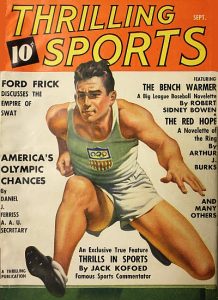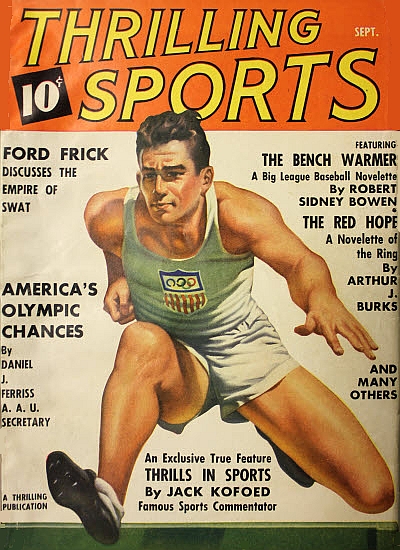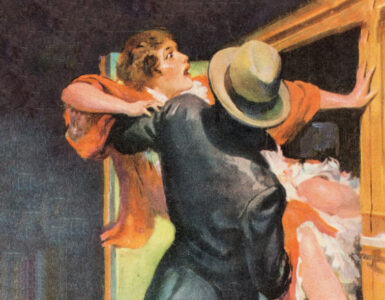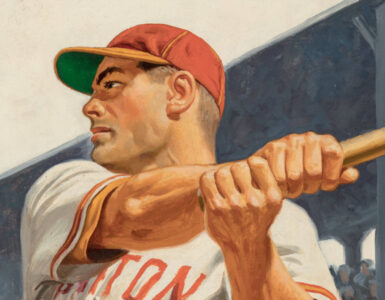 Although sports have long been part of our history–native Americans are known to have played a primitive form of lacrosse–it was not until 1896 and the introduction of Gilbert Patten’s Frank Merriwell that sports became established in American popular fiction. From 1896 through 1916, Frank and his relatives appeared in more than 1,000 issues of Street & Smith’s story paper TIP TOP WEEKLY and its successors. After the nickel weekly’s demise, the Merriwells’ adventures continued elsewhere in the Street & Smith line of publications, including TOP-NOTCH MAGAZINE and SPORT STORY MAGAZINE, the first all-sports pulp magazine. All told, there were more than 500 million copies of Merriwell periodicals released by the publishing giant over the years.
Although sports have long been part of our history–native Americans are known to have played a primitive form of lacrosse–it was not until 1896 and the introduction of Gilbert Patten’s Frank Merriwell that sports became established in American popular fiction. From 1896 through 1916, Frank and his relatives appeared in more than 1,000 issues of Street & Smith’s story paper TIP TOP WEEKLY and its successors. After the nickel weekly’s demise, the Merriwells’ adventures continued elsewhere in the Street & Smith line of publications, including TOP-NOTCH MAGAZINE and SPORT STORY MAGAZINE, the first all-sports pulp magazine. All told, there were more than 500 million copies of Merriwell periodicals released by the publishing giant over the years.
The first issue of SPORT STORY MAGAZINE, dated September 8, 1923, sold for 15¢ and contained a variety of sports fiction, ranging from baseball, boxing and horse racing to polo, auto racing and tennis stories. Except for the occasional yarn in the general-fiction pulps such as ARGOSY and BLUE BOOK, SPORT STORY would have the market to itself for most of the next five years. It was not until the introduction of FIGHT STORIES during the spring of 1928, that another sports pulp would emerge. However unlike SPORT STORY, the Fiction House pulp focused solely on boxing stories.
With the collapse of the world economy in 1929, the sports pulp market would remain relatively stagnant during the early years of the Great Depression. It would not be until the summer of 1935 and the introduction of DIME SPORT MAGAZINE by Popular Publications that the genre would begin to take off. Over the next five years, twenty-five new sports pulp titles would be introduced to American readers. One of the leading publishers in the rapidly expanding market would be Ned Pines’ Standard Magazines, also known as the “Thrilling Group” of pulps. From 1936 through 1953, Pines’ company would publish about 230 issues of their sports pulps.
Standard’s foray into the sports pulp market began much like that of Street & Smith: THRILLING SPORTS, introduced during the fall of 1936, featured a wide range of sports fiction, from baseball and football yarns to track-and-field stories and hockey and horse racing tales. It likewise featured a variety of authors, including western writers Tom Curry, Giles Lutz, and in later years, Louis L’Amour; science-fiction stalwarts Nelson Bond, Ray Cummings, and Oscar Friend; detective dramatists William Campbell Gault, Richard Sale, and Robert Leslie Bellem; and aviation addicts Joe Archibald, George Bruce, and Robert Sidney Bowen. Standard would follow its “Thrilling” title with POPULAR SPORTS MAGAZINE in 1937 and EXCITING SPORTS in 1940. It would enter the specialty sports market–long the province of Fiction House–in the fall of 1939 with THRILLING FOOTBALL. POPULAR FOOTBALL and EXCITING FOOTBALL would follow in 1941.
Like all of the Thrilling titles of the time, the sports magazines were under the guidance of managing editor Leo Margulies–himself a topic at this year’s PulpFest–who wrote:
“The wide field of sports is covered by our magazines . . . Every branch amateur, professional, and collegiate athletics is covered; mature and vigorous stories, with real people and a hero facing a realistic problem. Human interest and woman interest are both desirable–for the stories should be slices of life. Solid story structure must bolster any sport angle. No sport story should ever be so nearly plotless as to read like a newspaper report of a game. Naturally, sport scenes must not be ignored to build up plot, but the plot should be forwarded by them, should grow out of the sport conflict, whether the story is told from the point of view of the hero, the trainer, the coach or an observing friend. . . . Be meticulously careful about the authenticity of the sport material. Keep the story adult! American readers are essentially sport-minded. They are eager for good sport stories, whether about baseball, football, swimming, horse racing, motorboat racing, water polo, golf, tennis, rowing, track, boxing, or any other sports that keep young and old Americans out in the open rooting for their favorite exponents of their favorite game.”
Please join PulpFest 2015 on Thursday evening, August 13th, as we welcome journalist Michelle Nolan to discuss the evolution of the sports pulps. Ms. Nolan has been a newspaper and magazine feature writer for fifty years, covering human-interest features, pop culture, and sports. She has written more than five hundred comics-related features for magazines such as COMIC BOOK MARKETPLACE, COMICS BUYER’S GUIDE, ALTER EGO, and COMIC BOOK ARTIST. She wrote 100 consecutive “Nolan’s Notebook” columns for COMIC BOOK MARKETPLACE from 1993 to 2005. She has contributed to dozens of books and wrote the ground-breaking book LOVE ON THE RACKS: A HISTORY OF AMERICAN ROMANCE COMICS, published by McFarland in 2008. She is also the author of BALL TALES: A STUDY OF BASEBALL, BASKETBALL, AND FOOTBALL FICTION OF THE 1930S THROUGH 1960S, published by McFarland in 2010. She received an Inkpot Award for her work at the 2014 San Diego Comic Convention.
“Play Ball: A Look at the Sports Pulps” will take place on the second floor of the Hyatt-Regency hotel in beautiful downtown Columbus, Ohio, beginning at 10:50 PM on August 13th. Register for “Summer’s Great Pulp Con” to be sure not to miss the first pitch by clicking here.
(The first issue of THRILLING SPORTS was dated September 1936 and featured “The Hurdling Hurricane,” credited to Arthur William Rickard, as its cover story. Also featured were baseball, boxing, auto racing, horse racing, and tennis stories. One of the authors whose work was included in the first issue was Ford Frick. In 1951, Frick became the Commissioner of Major League Baseball. The cover art for the issue was by Earle K. Bergey, who, along with Rudolph Belarski, created many cover paintings for Standard’s sports pulps.)







